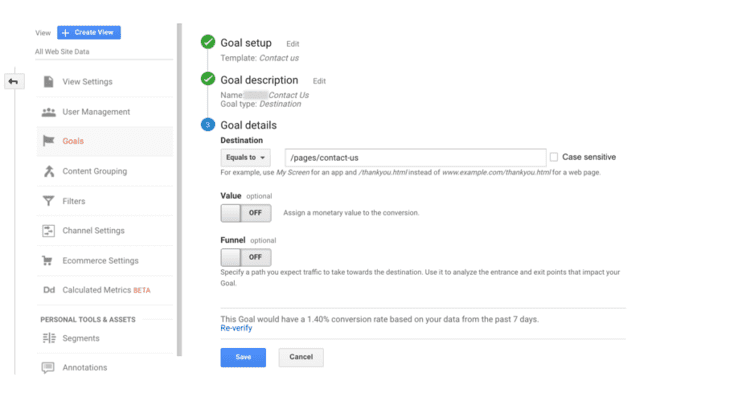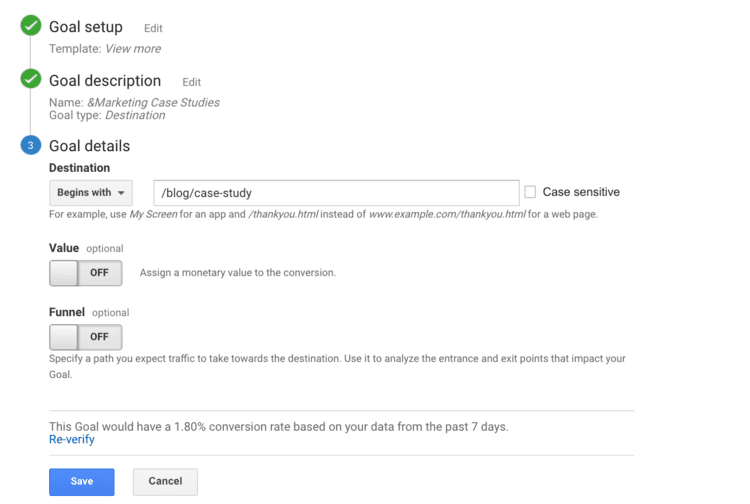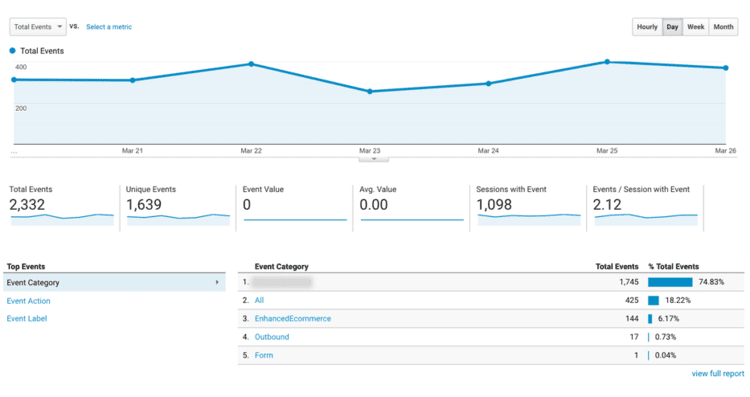Are you tracking the actions taken on your brand’s website? Google Analytics is a free tool that provides baseline metrics for your site and, when utilized correctly, can help you further determine how people interact with it. Through Google Analytics Goals, any organizations can set up customizable actions across a website. Setting up goals for the primary actions users will take on your site is pivotal for segmenting analytics data based on those actions, which gives you insight into what’s attracting and converting customers and what’s not.
Some Google Goals can be set up with ease, while others require custom code and a web developer. However, with proper setup, goals will help you strategize your approach to marketing your website. Here are four examples of goals you should make a priority to track through Google and why these goals are important for your business.
Contact Us & Submission Pages (and Visits)
Unless your website was designed in 1982, chances are you have a Contact Us page where visitors are able to input their information, reach out to someone at your company, and expect to receive a response. Similarly, many websites also utilize landing pages to feature relevant and specific sales messaging in hopes to get users to sign up for the product or service by providing their contact details. With Google Goals, you are able to track how you acquired the contact information from people who took action on these pages.
Why It’s Important
This goal allows you to see which acquisition channels are driving the most submissions, which is essential to gathering intel on the types of landing pages that are triggering more interactions with customers, so you can focus marketing efforts on the methods you know are working. Here are the steps to take for tracking submission page goals:
How to Set It Up for a Submission Landing Page
- Create “Thank You” page for visitors to land on after successful form submission
- Identify URL of “Thank You” page (everything after domain name)
- ex) yourwebsite.com/thank-you
- You will be using /thank-you
- ex) yourwebsite.com/thank-you
- Create Google Goal within Analytics
- Click “New Goal” and select “Contact Us” in the first step
- Name your goal and select the destination
- ex) Contact Us Submissions
- Enter your URL slug identified previously
- Make destination is set to “Exactly”
- Verify your goal to confirm it’s working
- Save

You can also create a goal to track the amount of contact page hits you receive so that you can review that against the number of submissions you generate. A bad hit to submission rate would suggest that you need to simplify your form. Simply follow step 3 and make sure the destination is just the URL for your contact page.
Content Views
If you have ongoing content on your website— which you should to further educate your audience and for SEO purposes— there is a good chance it is all grouped up under a similar URL structure. Most commonly, websites will use www.yourwebsite.com/blog/xyz or youwebsite.com/blog/case-study-xyz. A Google Analytics Goal set to track these URL links as a whole will help you identify how many times your content was viewed and how you acquired those individuals.
Why It’s Important
This Google Goal helps you group content together to determine how many people viewed content and how these viewers found your content. Tracking content traffic allows you to make decisions based on the kind of content users are responding in order to best leverage that interest. Below are the steps to take for tracking content goals:
- Identify the URLs of your blogs, case studies, downloads
- Create Google Goal within analytics
- Click “New Goal” and select “Contact Us” in the first step
- Name your goal and select destination
- ex) Case Study Views
- Enter your URL slug
- ex) /blog/ or /case-study
- Make sure the Destination is set to “begins with”
- Verify your goal to confirm it’s working
- Save

eCommerce Goals
For eCommerce companies, enabling eCommerce goals and tracking for analytics provides an abundance of insightful data on how an action is taken across the site. This intel includes cart abandonments, average order value, and total transactions across any time period. eCommerce is not difficult to enable for your site, but the details depend on what platform your eCommerce is hosted on.
If you already have Google Analytics installed, most eCommerce platforms either automatically provide the data or come equipped with plugins. This includes:
- Woocommerce / WordPress
- Shopify
- Squarespace

Why It’s Important
eCommerce goals with Google Analytics provides in-depth product and cart behavior, including how much people bought and the average order value of all purchases. This intel allows you to make decisions on what marketing tactics to execute for more orders on your site in addition to insights on cart abandonment that can help you course correct any path to purchase issues. Below are the steps to take for tracking eCommerce goals:
- Install Google Analytics eCommerce tracking code on the website
- See how to here: https://ducttapemarketing.com/ecommerce-tracking/
- Enable Plugins (as needed)
- Woocommerce plugin recommendation: https://wordpress.org/plugins/woocommerce-google-analytics-integration/#reviews
- Shopify: https://help.shopify.com/en/manual/reports-and-analytics/google-analytics/google-analytics-setup
- Squarespace: Default Setting
- Enable eCommerce and enhanced eCommerce reporting
- Enhanced eCommerce reporting gives you access to more insights, including funnel steps taken by users, and only requires that you have the newest version of Google Analytics installed on your website.
If you are still having trouble accessing this data, custom code may need to be implemented to force the data through the system. Let &Marketing know if you are experiencing this, and we’ll be happy to help you set it up.
Event Tracking
Google Event tracking is an advanced way to gather insights on actions taken across your website. Through implementing a custom code, event tracking gives you the ability to specifically view actions taken on buttons and links, even if they are located within a PDF download on your website. Event tracking is a useful tool for tracking these actions and more:
- Downloads
- Phone calls
- Videos
- Clicks to external links
Why It’s Important
Event tracking lets you track actions on the website that require extra code and provides acquisition insights on individuals who performed the website actions. You can learn what elements are gaining the most traction on your site to better inform your decisions on how to structure your pages to create the most conversions. Here are the steps to take for Event tracking goals:
- Understand the custom code and assign values manually.
- You must assign a value to ‘Event Category’ and ‘Event Action’. Below is a description for each value option:
- Event Category: Typically the object that was interacted with (example: “video”). This is mandatory.
- Event Action: The type of interaction (example: “play”). This is mandatory.
- Event Label: Useful for categorizing events (example: “summer campaign”)
- Event Value: A numeric value, often monetary, associated with the event (example: “42”)
- Create the custom piece of code in-line
- ga(‘send’, ‘event’, [eventCategory], [eventAction], [eventLabel], [eventValue]);
- You must assign a value to ‘Event Category’ and ‘Event Action’. Below is a description for each value option:
- Add the custom code to the website page
- You may need to consult web developer or your marketing agency for assistance
- Create new goal in Google Analytics
- Select “Custom” in the first step
- Name your goal and select event
- ex) White Paper Download Views
- Input the same values as assigned in step 1
- Verify your goal to confirm it’s working
- Save

Google Analytics Goals provide you with information to make informed decisions on how your audience and marketing tactics engage with your site. Goals can be quickly set up and provide valuable insight for your organization’s marketing strategy. The team at &Marketing has installed all of the goals above and more, and utilize the data provided by these goals to determine where to focus our marketing efforts in order to build growth for our client partners.
If you are looking to install Google Analytics Goals and don’t know where to start, we’re here to help! Contact us today to learn more.
